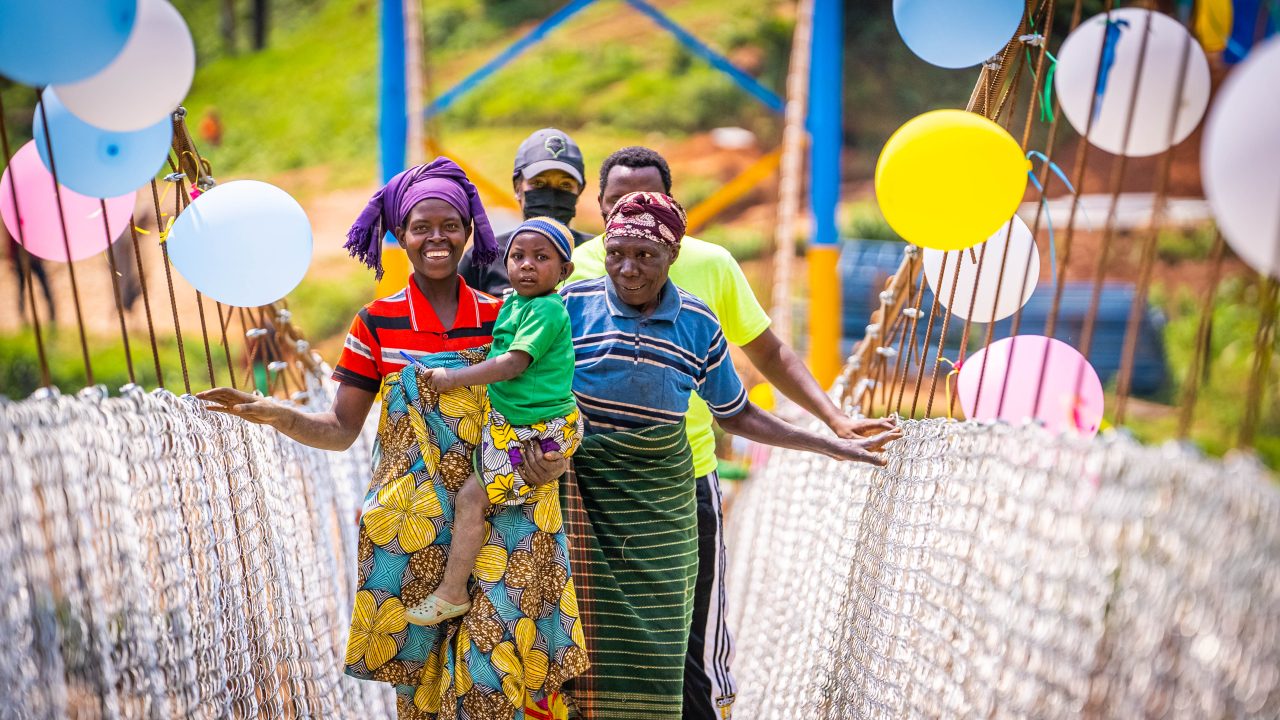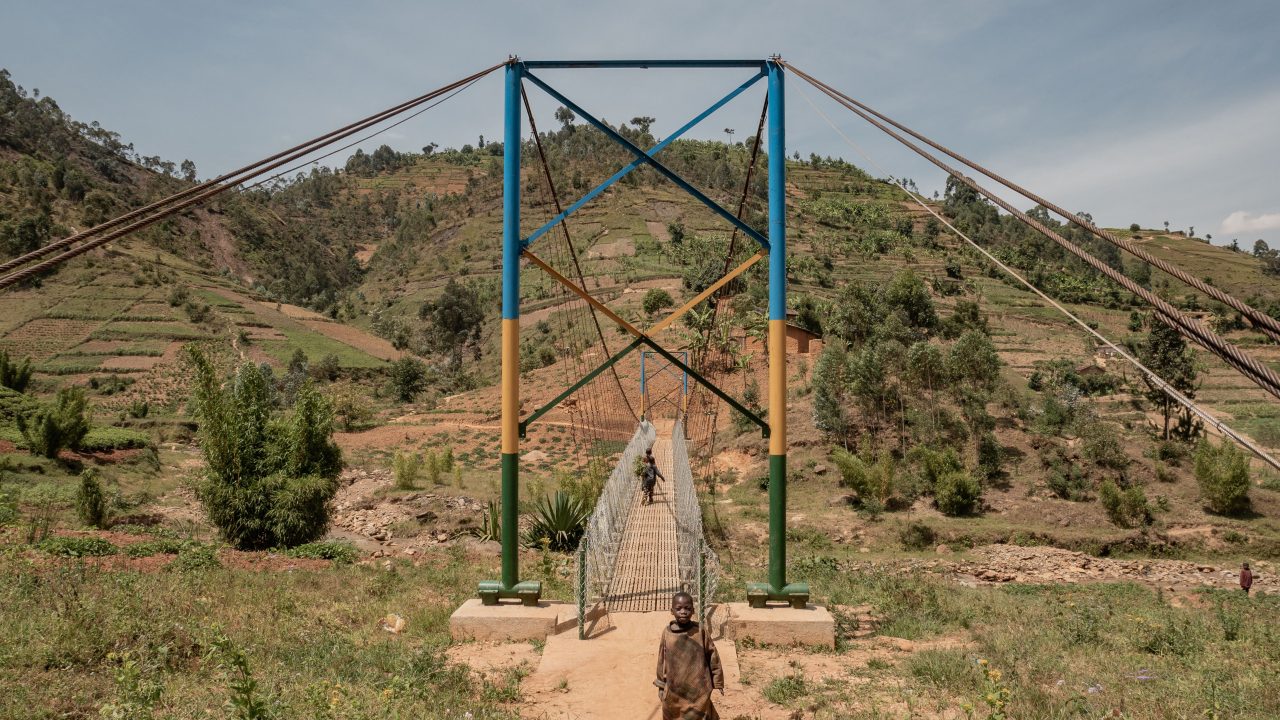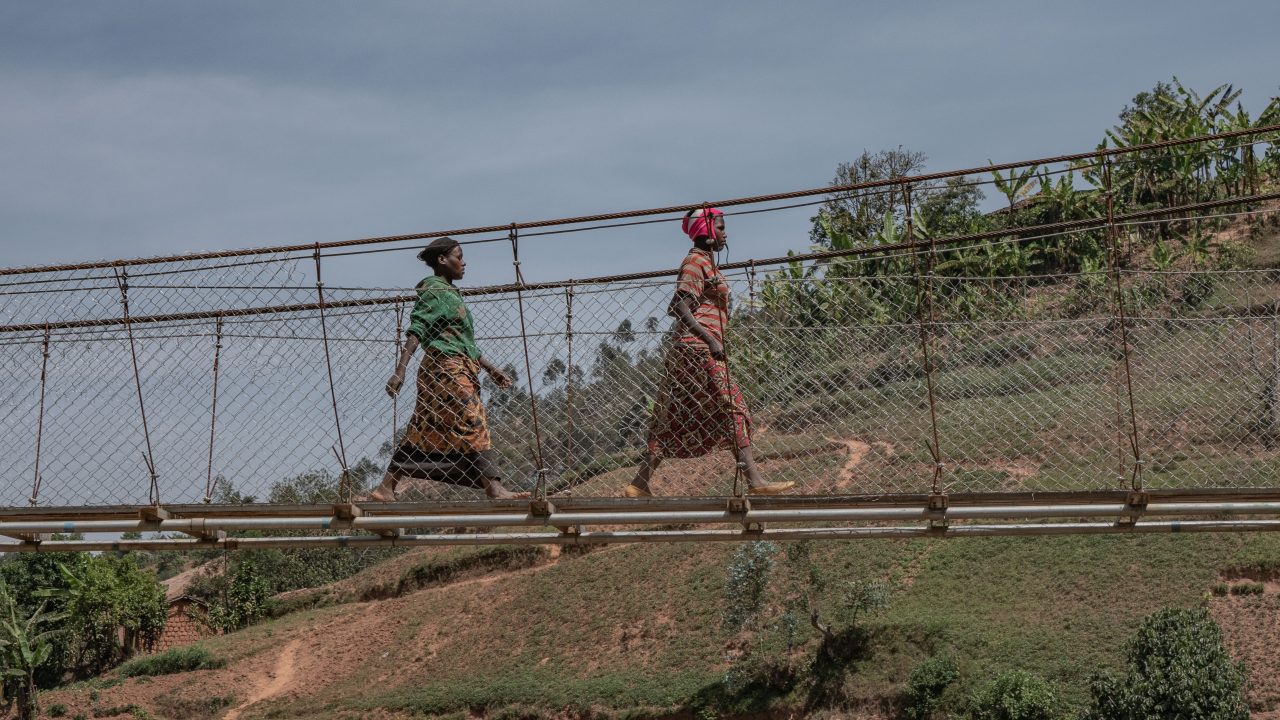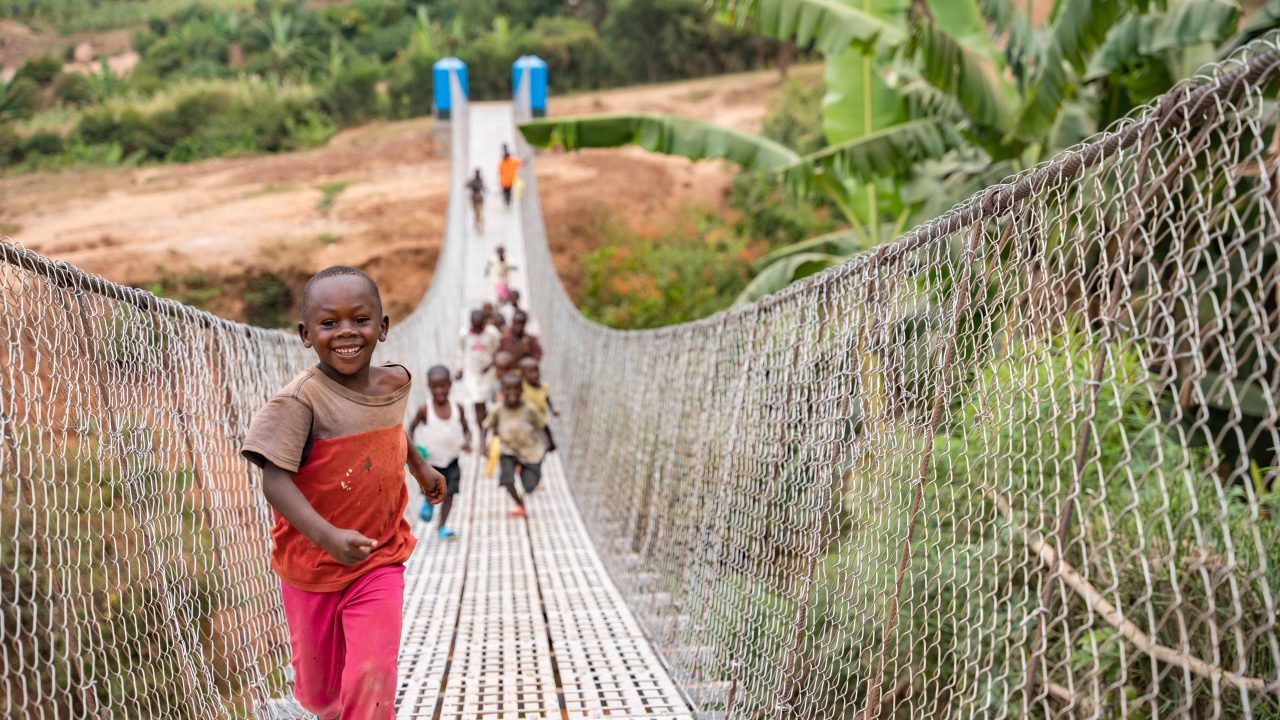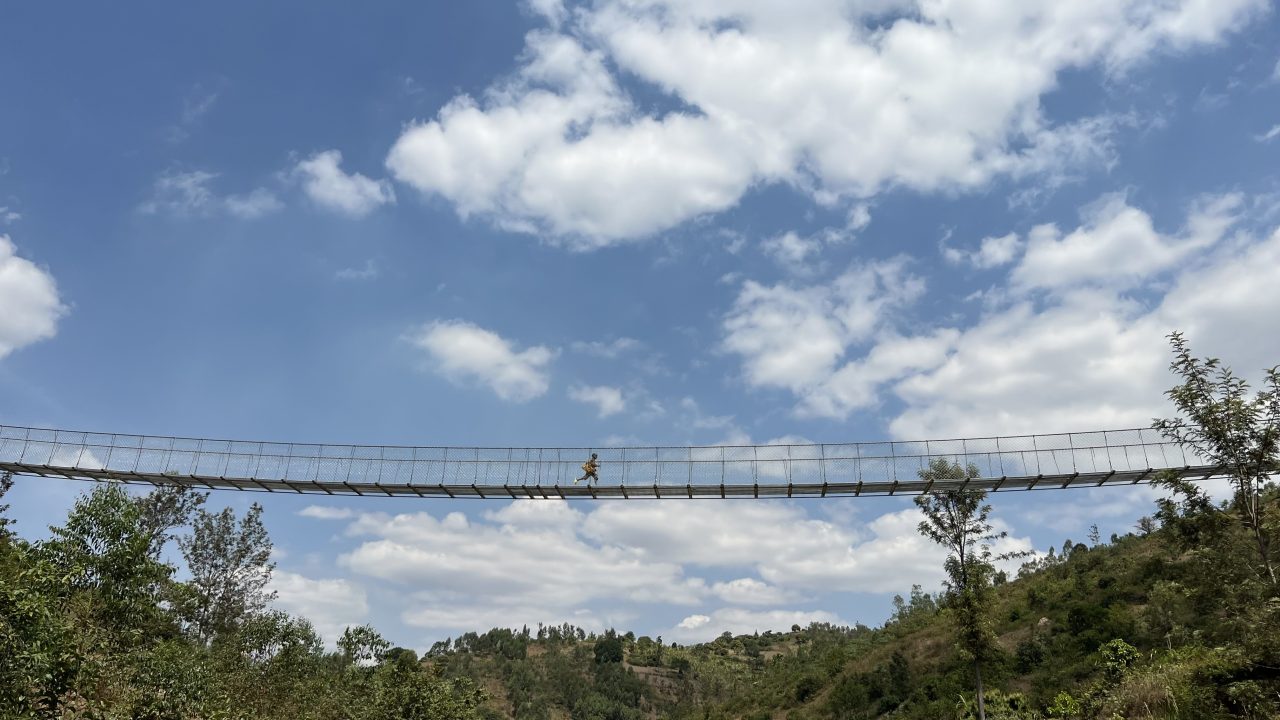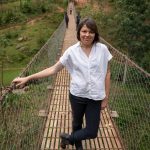It started with a photograph.
Ken Frantz was flipping through a copy of National Geographic in 2001 and an image stopped him in his tracks. Men dangling high in the air, using a rudimentary ropes system to dangerously cross a river—a broken bridge crumbling on either side of them and the Blue Nile in Ethiopia rushing below.
As the owner of a construction company, Frantz knew that the problem was solvable.
It took Frantz and his team just three months to get that bridge rebuilt. Now, more than 20 years and nearly 500 bridges later, that mindset—seeing big challenges like rural isolation and poverty as solvable—fuels a new data-driven chapter for Bridges to Prosperity (B2P), a nonprofit that aims to meet an estimated global demand for 100,000 bridges serving 250 million people—one bridge at a time.
Rwabagenzi Suspension Bridge
The Bridge to Prosperity team has been working with the community on the construction of the 78m Rwabagenzi suspension bridge in Nyarugenge district Kigali, Rwanda, which will connect over 4,500 rural residents to new opportunities.
The Challenge
Rural isolation is a root cause of poverty.
Access to nutritious food, education, and health care—powerful social determinants of health—all depend on sufficient transportation infrastructure to get to markets, schools, and hospitals. Without access to these critical resources, health and economic equity gaps widen. People risk their lives to travel unsafe routes or go without altogether.
Globally, B2P’s monitoring and evaluation program has identified an estimated 1.3 million people who do not have safe access to these resources, threatening their lives and livelihoods. Yet Abbie Noriega, the Chief Impact Officer for B2P, says so many people—even those working in global development and government—are unaware of the scope of the issue.
One reason the problem is not more well known is a lack of reliable data.
“For the most part, it just doesn’t exist,” Noriega said. “No governments in the world understand and have documented well the infrastructure gap in the rural context. We are missing data as simple as rivers and roads for a huge portion of the world.”
The data may not yet exist, but the case for impact is strong.
“We construct tangible bridges. When I present a picture on my phone and say, ‘Here is the bridge,’ and I see the realization dawn on people’s faces ” said Global Advocacy and Partnerships Director Eniola Mafe-Abaga. “In an era obsessed with groundbreaking innovations and complex ‘blockchain/data/disruptive technologies,’ our work stands out as a straightforward, evidence-backed solution with the power to transform lives.”
In this day and age where we’re supposed to find these revolutionary, amazingly innovative, ‘NFT-slash-data cube-slash-disruptive technology,’ this is a very clear, proven intervention that changes lives.
Eniola Mafe-Abaga Global Advocacy and Partnerships Director Bridges to Prosperity
The Solution
Twenty-plus years ago, Ken Frantz saw a simple problem with a simple solution. So, he rallied his network, and they built a bridge. And then another, and then another.
B2P today has trail bridges in 21 countries.
For the organization’s first decade, the team focused on mastering the technical challenges associated with securing materials and labor and transporting them safely in some of the most remote, and often geographically challenging, environments in the world. They are now masters at their craft, and it typically takes just eight weeks to construct a bridge.
With the practical execution perfected, B2P’s focus has increasingly shifted to maximizing cost efficiency and durability, building greater trust with governments and community partners, and—now, more than ever—building bridges that are sustainable and climate resilient.
Equally important is advocacy.
“Redirecting even one percent of global infrastructure spending toward trail bridges could be transformatives, would be transformative,” Mafe-Abaga said. “The evidence for their impact is robust. Our current focus is on disseminating this knowledge to those who can implement these projects broadly. The ultimate goal is for governments to be resourced, willing, and able to sustainably construct these bridges for their communities.”
Building that kind of widespread public will and demand requires better data, an area in which B2P has experienced significant growth since its early days.
Before B2P sets out to build a new bridge, prospective locations are identified through robust needs assessments. B2P connects with national governments to begin to build support and gain permission. Then they train local needs assessors to conduct social and technical assessments and convene public meetings and focus groups.
Working closely with the community, these assessors compile as much data as possible, from the disparity in heights between banks to the number of past mortalities on site. Catchment surveys help them understand how people are using crossings, both before and after a new bridge has been constructed.
“It’s a much more community-driven, locally-driven process. You can never replace local knowledge,” Noriega said.
That information is added to a centralized, growing database of global information that includes coordinates, photographs, and information on a massive network of partners on the ground. B2P sees significant opportunities ahead for how geo-mapping technologies and AI can accelerate their work and are in the beta testing phase of Fika Map, a suite of remote analysis tools that use machine learning to locate where access is most beneficial.
The tool has the power to make B2P solutions more scalable and replicable than B2P’s founder could have ever imagined.
In the meantime, they continue to solve major challenges for the communities they serve. According to B2P, easier access to health care leads to an 18 percent increase in care visits. There is a 30 percent increase in labor market income and a 75 percent increase in farm profits when people have year-round access to the local marketplaces. Twelve percent more children enroll when they can access school.
B2P’s data also shows that social connection is the top reason that rural communities are crossing their bridges.
“A connected community is a resilient community,” Noriega said. “It’s one of those things that makes life worth living.”
There are so many complicated problems that are going to take centuries, millennia to solve. The one we’re trying to solve is actually not one of them. It feels like a rare opportunity to say I'm working on something, and I'll probably see pretty massive global results in my lifetime if we do this right.
Abbie Noriega Chief Impact Officer Bridges to Prosperity
The Takeaway
B2P is a bit of an outlier in the nonprofit field. They don’t fit neatly into the category of health care, education, climate, or gender, but the work they do influences all those dimensions of life.
“This is one of the best investments you can make, dollar for dollar, in poverty alleviation,” Noriega said.
Everyone at B2P has a personal story to tell about their experiences visiting one of their bridges. For Noriega, she was at a bridge site in Haiti when she noticed that everyone she saw crossing while carrying something—a child, cargo, an animal pulling a cart—was a woman. In Rwanda, Mafe-Abaga watched a young boy, maybe 3 years old, running across the bridge, and she was struck by the realization that the bridge would exist and serve his community for the entirety of his life.
Caitlin McWhorter, the Director of Marketing and Communications, has been to three or four bridges in Ethiopia and returns home each time proud and excited to tell her daughters about the work she’s helping to advance.
“Being able to talk to my kids about that makes me so proud,” she said. “Without these bridges, kids can’t go to school. Women can’t get to hospitals to have a baby. It’s a profound feeling, getting to see how this work—this simple intervention—is actually life-changing.”
A simple intervention with an outsized impact and a goal that the B2P team believes is achievable if they continue to do what they do best, while using data to accelerate the adoption and replicability of trail bridges around the world.
“There are so many complicated problems that are going to take centuries, millennia, to solve. The one we’re trying to solve is actually not one of them,” Noriega said. “It feels like a rare opportunity to say I’m working on something and I’ll probably see pretty massive global results in my lifetime if we do this right.”
